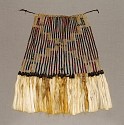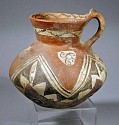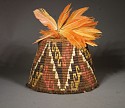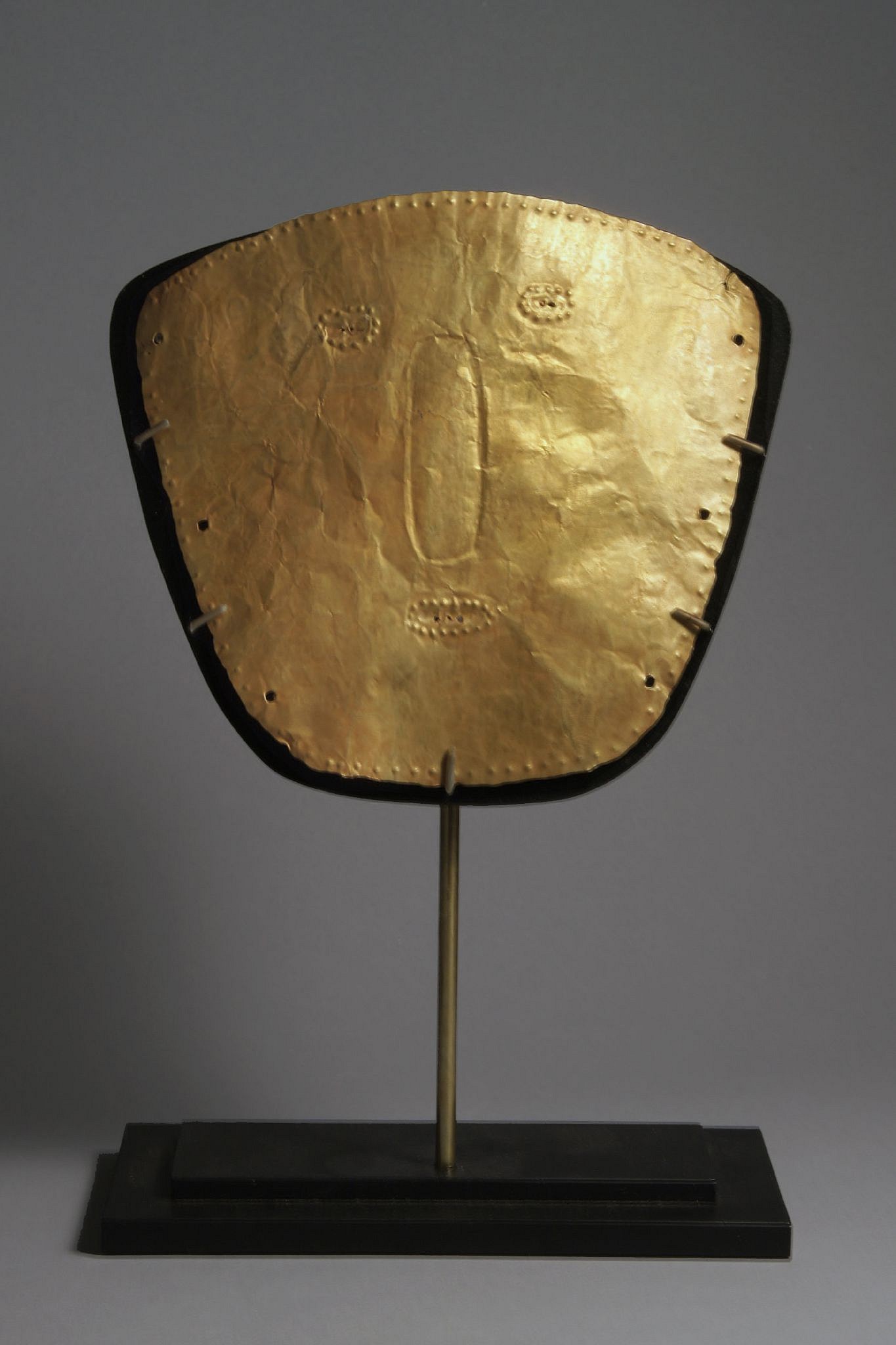

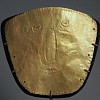

Chile, Diaguita Style Gold Mask with Repoussé Eyes, Mouth and Border
The eyes and mouth have pierced holes to attach turquoise eyes and a shell mouth. The six holes on the side of the mask were for tying the mask to the mummy. There are very few gold masks found in Chile because partly because that there was little gold available from rivers. The little-known gold that has been found in Chile was probably traded with Bolivia or even Peru. This mask is one of three that were supposedly found in Northern Chile near Arica. Very few masks from Arica are known as the area was poor and gold had to have been imported. The tradition of these simple masks goes back to the Chinchorro culture (circa 7,000 BC) of Northern Chile. I have found one gold diadem now in the American Museum of Natural History in New York which has a similar nose design. It is safe to say that this mask most closely resembles the same facial designs on the Diaguita ceramics from La Serenna - the round eyes, straight vertical nose and the horizontal mouth. The repousse design around the edge relates to the painted spots on the ceramic face. With this mask came a gold headband or turban, measuring 36" x 3/8" in width. The headband has the same repousse design on the edges. The gold content was tested at 17KT. and has been annealed and burnished to a thickness of 1/128"
Period: Chile, Diaguita Culture, Northern region, c. AD 1200 - 1470
Media: Metal
Dimensions: Width 6" x Height 5 1/4" Weight: 4.6 grams
XRF Au.69%, Ag.26% Cu. 4%
Price Upon Request
M7166
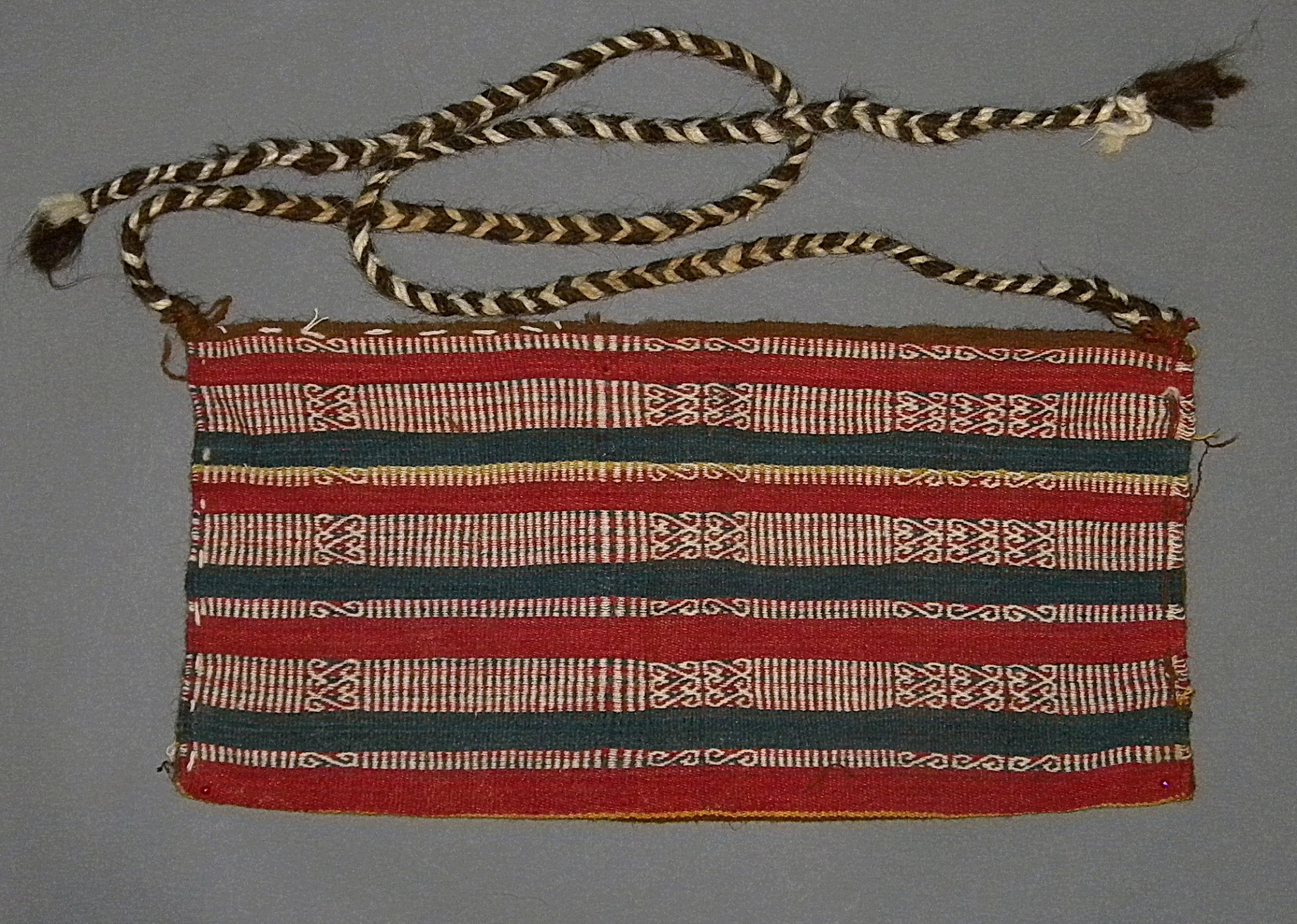


Chile, Inca Faja Bolsa (Bag Belt)
This Faja Bolsa has extremely good colors and presevation, in blue, red and white. geometric striped design. The belt was worn around the waist and over a tunic. As tunics have not pockets, the bag belt allowed the wearer to store items from coca leaves to corn, something like a Money Belt is used for today. A similar example is found in "Arica, Diez mil Anos", Museo Chileno de Arte Precolombino, page 80, no. 180 & 181. Woven of alpaca wools. Weavings from Pica, Chile are usually in excellent condition with bright colors.
Period: Chile, Inca Pica, circa AD1470-1535
Media: Textile
Dimensions: Width: 6 x Length:. 17 � in.
$2,750
90247
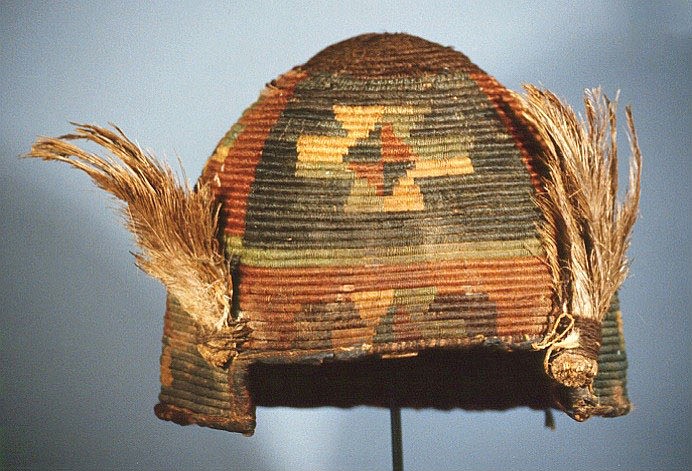




Chile, Pre-Inca helmet from Chile with Extended Cross Design
A coiled and reed cone shaped helmet and decorated with crosses within squares in alternating colors of blue and salmon with a blue lower border. A similar helmet is illustrated in IDENTITY AND PRESTIGE IN THE ANDES pg.44. The Andean civilizations never developed a piercing technology but utilized a clobbering warfare and needed insulated
Period: Chile, Tiwanaku, Alta Ramirez Arica, circa AD450-800
Media: Textile
Dimensions: Height 11" Diam 9"
Price Upon Request
91131
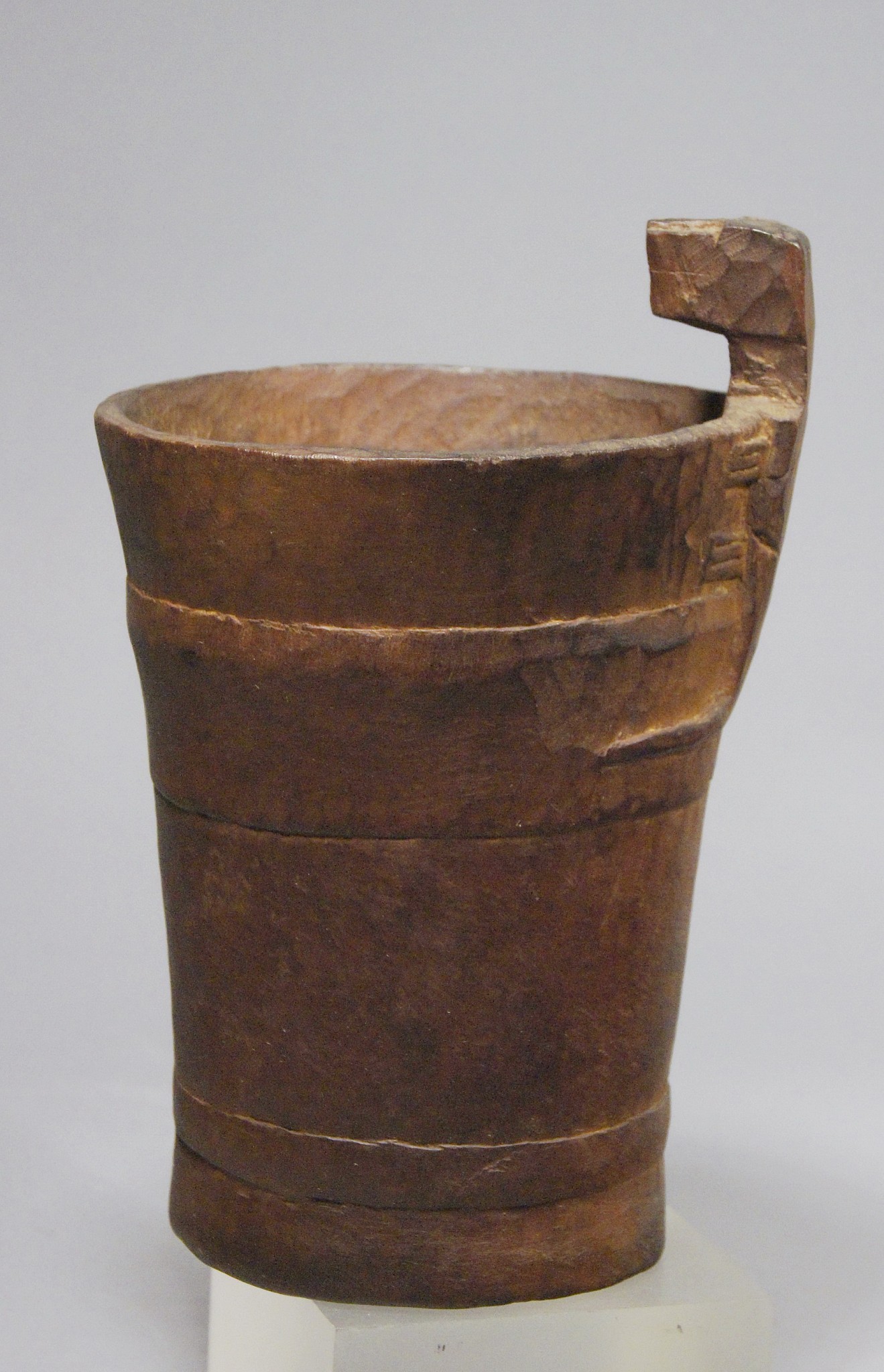




Chile, Arica Wood Kero with Lizard
This is a classic Arica cup, smoothly finished on the outside and roughly carved on the inside. A similar one has been exhibited and illustrated in the book "Arica, Diez mil Anos" (Museo Chileno de Arte Precolombino, 1991: fig. 050). Ricardo E. Latcham illustrates a cup of this type in "Arqueologia de la Region Atacamena: (1938: fig. 51). John Rowe describes these cups as the precursors to the classic Cuzco-style cups in his essay, The Chronology of Inca Wooden Cups in "Essays in Pre-Columbian Art and Archaeology" (1961: 317-341). The first example style kero was found by Gilliss and illustrated in the "U.S. Naval Astronomical Expedition to the Southern Hemisphere." (1856: III: pl. X).
Period: Chile, Arica, San Miguel, Phase North Coast, circa AD1100-1200
Media: Wood
Dimensions: Height 5 1/2" x Width 4 1/2"
$2,300
97133B
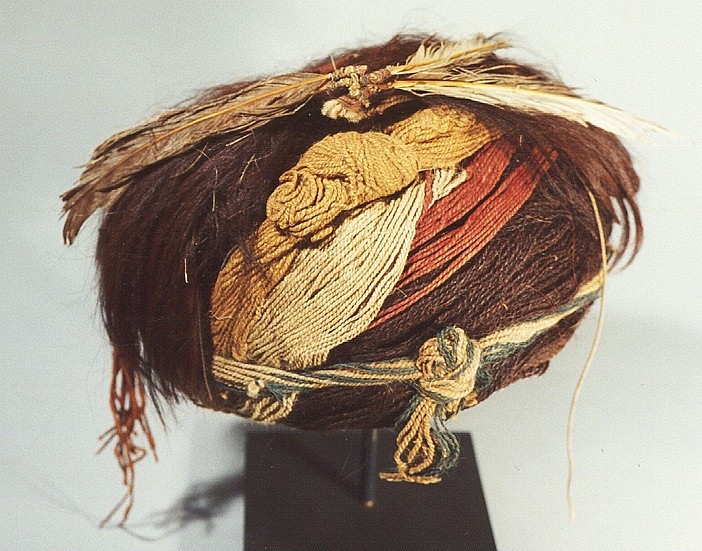
Chile, Cameronie turban with henna colored hair with upright fiber tassel
Cameronie is a coastal fishing center inhabited as early as 900 B.C. and occupied until 1100 A.D.. The turbans were made prior to the acceptance of weaving. Much importance was placed on head-gear in Chile.
Period: Cameronie, Chile, c. 600 B.C.
Media: Textile
Dimensions: Approx. Diameter 8 in.
$4,250
91283B
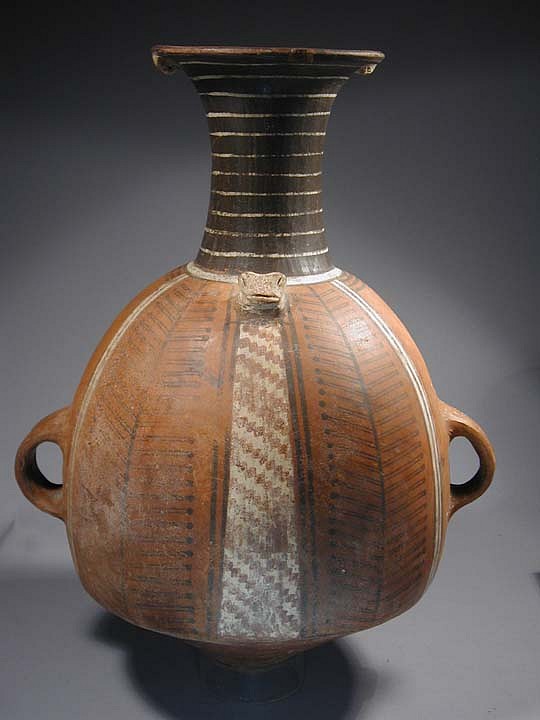


Chile, Arica / Inca Aryballus with geometric design from Chile
Although the Inca conquest of Chile lasted for a period of only seventy years until the arrival of the Spaniards, the magnitude of its aesthetic impact is undeniable. These two ceramic aryballus vessels are classic examples of that influence. Each vessel has two lug handles and a feline head knob to hold the temp line. Both are decorated in the expressively elegant geometry of the Inca. In very good condition with all original pigment intact. A similar example with a post fired cross hatching design is illustrated in Ceramics of Ancient Peru by Christopher donnan, fig 219. Another very similar example with the diamond motif is illustrated in "Chile Indigena", Museo Arqueologico de Santiago, Chile, 1991.
Period: Chile, Arica, Inca/Late Agroceramic Period, 1470 - 1536
Media: Ceramic
Dimensions: Height: 14"
Price Upon Request
96090A
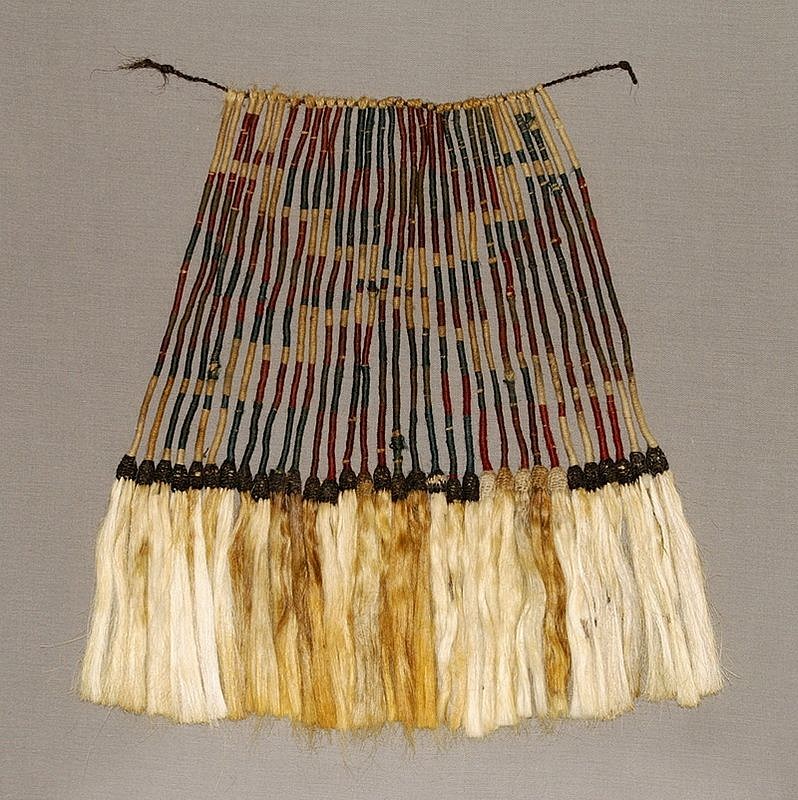




Chile, Arica Small Loincloth
The lion cloth is comprised of 32 individually wrapped strands of vicuna. The design of the Andean cross appears when the strands are aligned. A similar small mens loincloth is illustrated in Arica Diez Mil Anos, Museo Chileno (1985: 57).
Period: Chile, Arica, Inca/Late Agroceramic Period, circa AD1470-1535
Media: Textile
Dimensions: Height: 12" x Width: 14"
$6,500
M8063
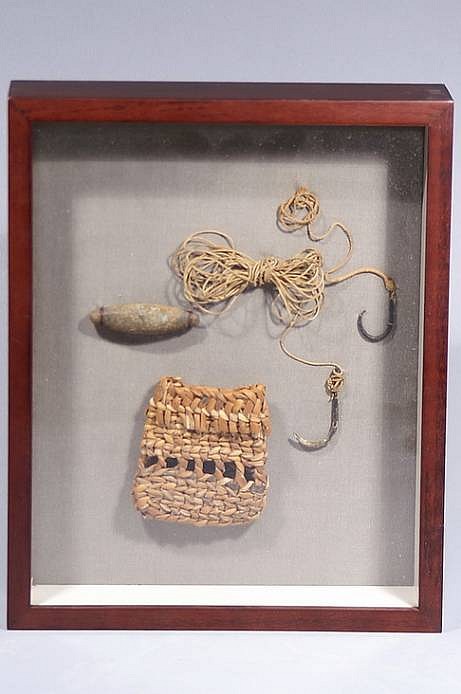



Chile, Arica Chilean Fishing Kit consiting of hook, line and sinker
This kit consists of a small finely woven basket for carrying the assembled items of fishing line with hook and sinker. The line cord is spun and plied of cotton. It is unusually well made, hard-spun, with a two-strand cord. There are two straight shank fish hooks, the smaller made of copper and the larger of cactus thorn - both without barbs. The sinker is cigar shaped stone. A fine cord lashing was used to attach the sinker to the loop of heavy cord. With this system, the weight could be easily attached to or removed from the line. Similar excavated fishing material is illustrated in "Excavations in Northern Chile," Anthropological Papers of the American Museum of Natural History (1943), and also in Junius Bird, "The Cultural Sequence of the North Chilean Coast," Part 3, Southern Andes, in "Handbook of South American Indians" (1946: II: 587-597).
Period: Chile, Arica, San Miguel, Phase North Coast, circa AD1100-1200
Media: Textile
Dimensions: Length 6 1/2, width 4 1/2 and Height 4 1/2 inches
Price Upon Request
M8049
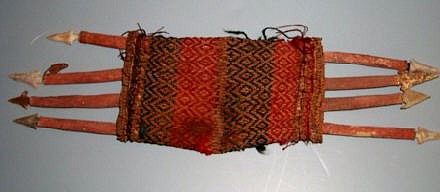
Chile, Arica harpoon quiver with harpoon points
A fiber quiver decorated in red and green reed, with its original wood harpoon points and napped points. The wood harpoon points are set into a longer throwing stick and the point releases when the harpoon is retrieved. The quiver also known as a Porta Harpoon (harpoon carrier) and holds eight points. It was used by the fisherman to hold his ammunition for an extended trip. Junius bird describes and illustrates these porta harpoons in "EXCAVATIONS IN NORTHERN CHILE", 1943 pg. 223.
Period: Chile, Arica, Formative Period, circa 1000 BC-AD300
Media: Textile
Dimensions: Length 23" from point to point x Width 7"
Price Upon Request
MM201
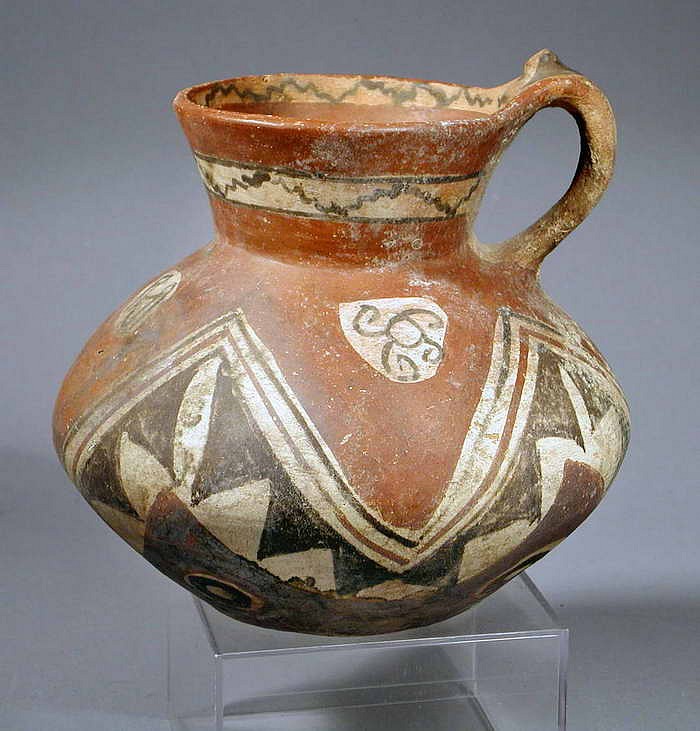


Chile, Arica Lug Handled Pitcher with geometric designs in black, white and red
San Miguel style white and black on red slip ground. The geometric design consists of four white circles inside a red ground, and underneath are a undulating bands of lines and triangles. Below this are black and white concentric cirles, and black and white bands inside and around the spout. The colors and designs are similar to a vessel illustrated in Cultures De Chile Prehistoria, Chile (1997: 196-a and d), and Excavations in Northern Chile by Junius Bird (1943: 199-jand f ).
Period: Chile, Arica, San Miguel Phase, North Coast, c. AD 1100 - 1200
Media: Ceramic
Dimensions: Height 6 1/2" x width 8"
$1,500
M3011
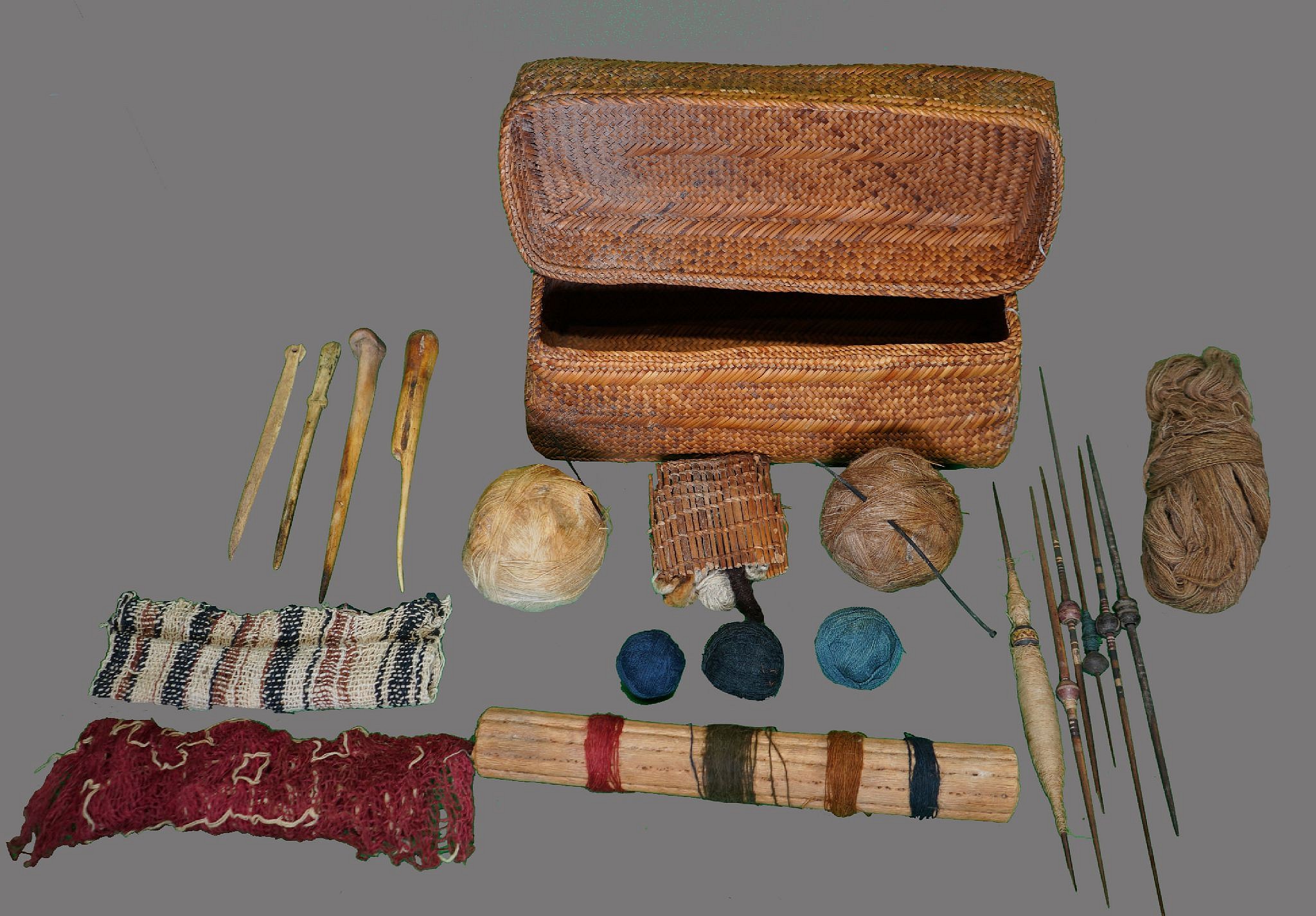
Chile, Chancay Basket with Weaving Implements
This rectangular reed basket with separate cover contains a complete ancient Peruvian weaving kit. The basket has bamboo ribs to support its shape. Based on the contents, it appears to have been used for weaving garments for Chancay dolls. The contents include: two large and three small wound balls of thread in a variety of colors, five spindle whorls, one bobbin, two thorn needles, two bone needles, a shed rod, and three small ancient woven panels. All the components are ancient and were found together in the basket.
Period: Peru, Chancay, Central Coast, c. AD 1100 - 1430
Media: Textile
Dimensions: H. 4 3/4 x L. 11 1/2 in.
Price Upon Request
91272
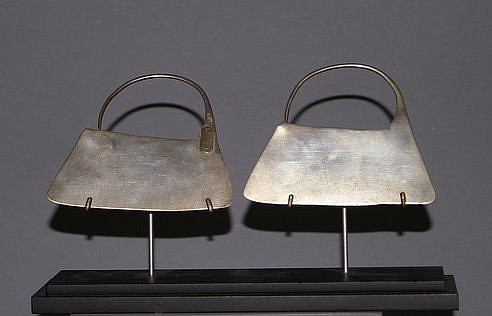





Chile, Classic Mapuche Trapezoidal Silver Ear Ornaments
This Mapuche ear ornaments are made from one continuous piece of hammered silver and feature the classic Mapuche trapezoidal shape. According to Mapuche tradition, these earrings would have been handed down to family members through multiple generations. They would likely have been repaired using primitive means by the family they belonged to.
Period: Chile, Mapuche, Tamuco Southern zone, c. AD 1890 - 1920
Media: Metal
Dimensions: Width 3 3/4: x Height: 3" Weight: 1.06 oz.
$2,900
M9042
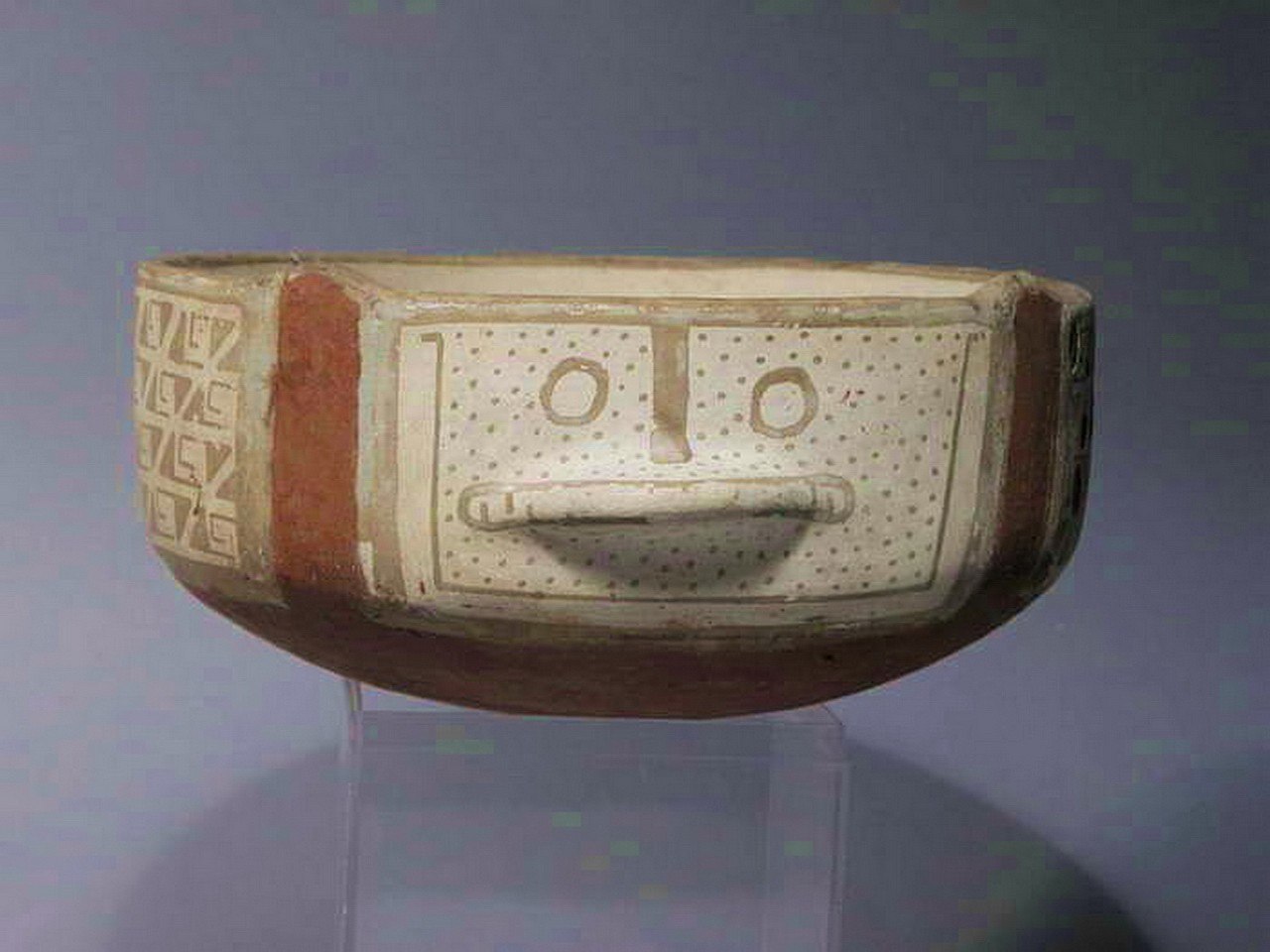
Chile, Diaguita Phase II Shallow Bowl with Animal Face and Step Frets
This second phase Diaguita bowl exhibits a ornithomorph with a protruding mouth and a small protrubance in the rear. The high outer walls are decorated with a band of repeating step fret symbols. A similar bowl is illustrated in "Chile Indigena, Museo Arqueologico De Santiago,Chile," pl. 76.
Period: Chile, Diaguita Culture, Northern region, c. AD 1200 - 1470
Media: Ceramic
Dimensions: Diameter 7" x Height 3 1/2"
Price Upon Request
M3143
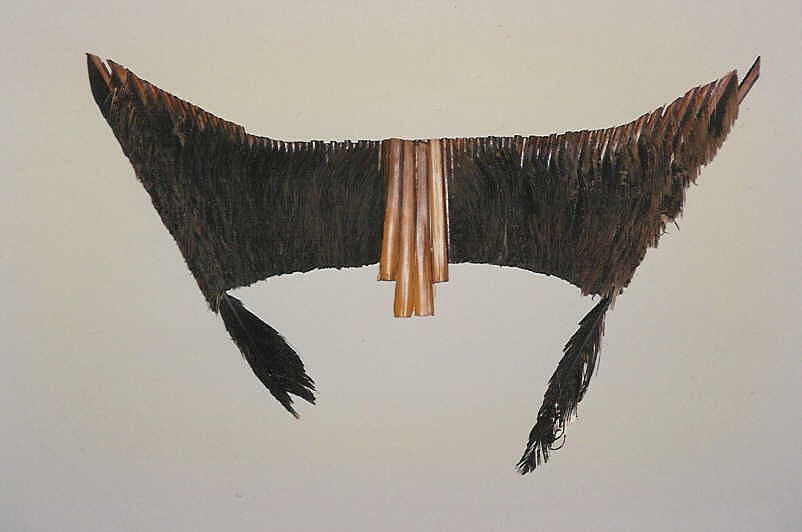


Chile, Inca feather shaman's mask with feather Nose appendages
This mask was worn by shaman to create an owl like impression. It is constructed by threading the individual duck feather quills. Figurative pottery images have been seen wearing this type of face mask. Similar masks are illustrated in ARICA 10,000 YEARS. Another example is illustrated in "Identity and Prestige in the Andes" pg 52.
Period: Chile, Late Intermediate Period, Arica North coast circa AD 1100-1200
Media: Textile
Dimensions: H 6 1/2" x W. 7"
$1,800
88033B
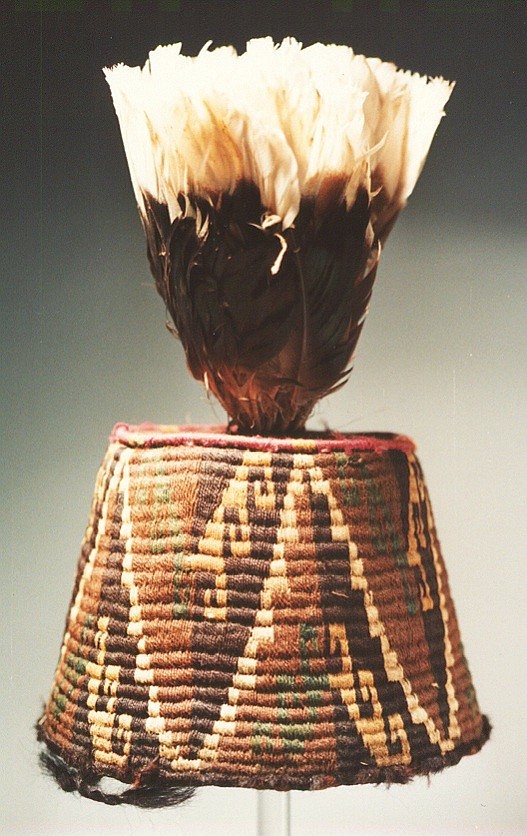
Chile, Inca Fez hat with step/scroll design in varying brown and green.
The hat has an undulating pattern of varying shades of brown. The green decoration is minimal and very subtle.
Period: Chile, Inca Pica, circa AD1470-1535
Media: Textile
Dimensions: diameter 4 1/2 in.
Price Upon Request
92229
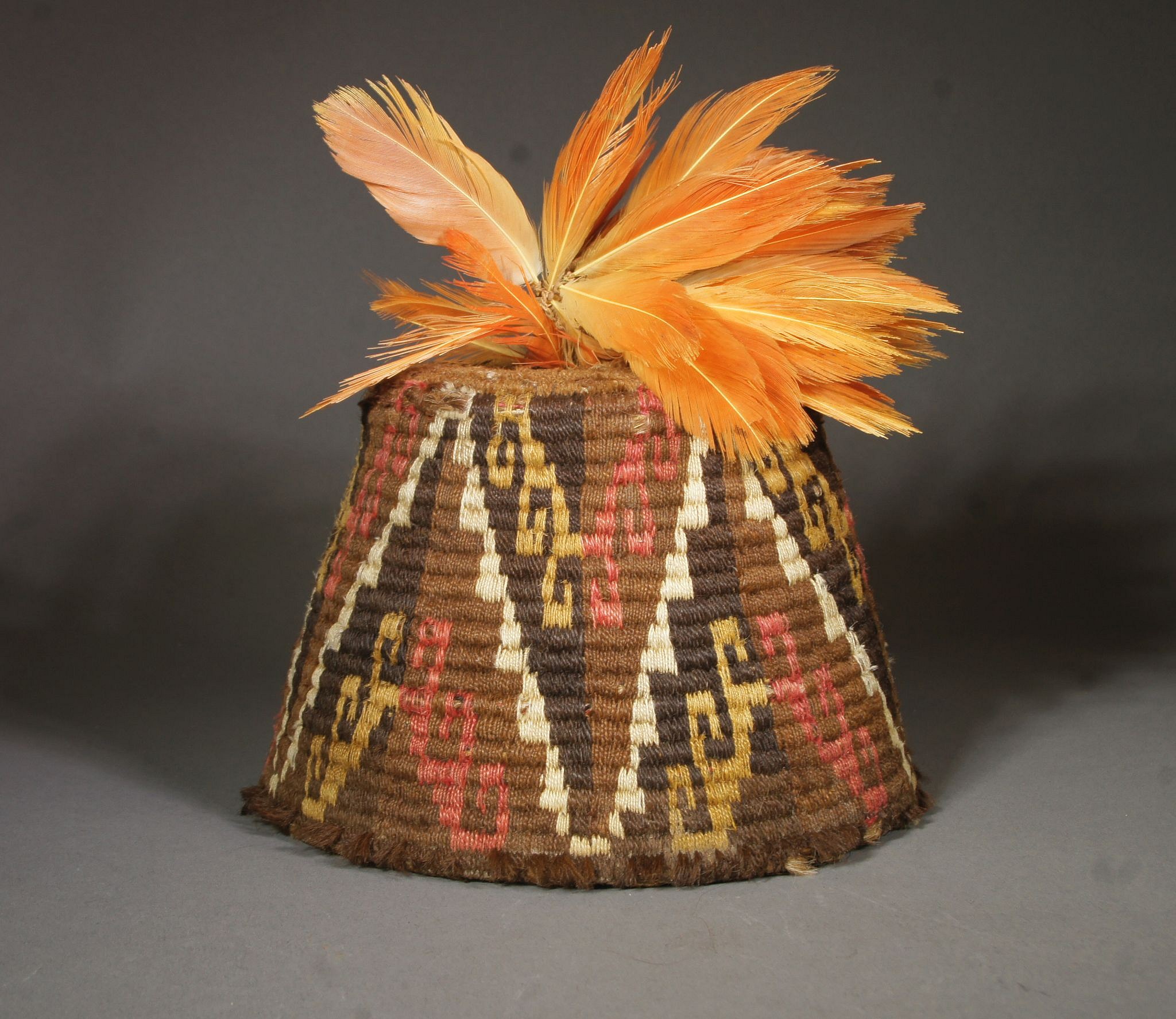



Chile, Inca fez style hat with step design in brown, gold, white and pink and feather plume
A fez style hat was placed as the final adornament on the Inca mummy bundles of Pica, Chile. They were not made anywhere else in all of the Inca Empire. They were made by a coil method wrapping different colored wool yarns around the coils to acheive the quartered step pattern. A similar example is illustrated in Arica Diez Mil Anos
Period: Chile, Inca, North Coast, Pica, c. AD 1470 - 1535
Media: Textile
Dimensions: H. 4 1/4 in.hat only H. with feathers 9"
Price Upon Request
91362
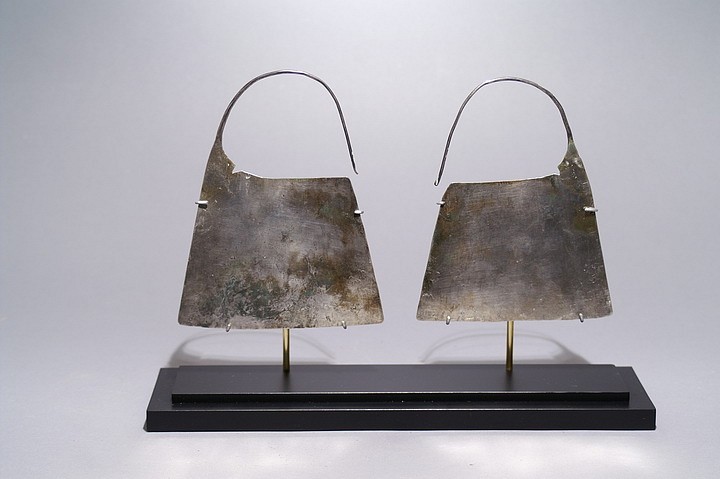


Chile, Large Mapuche Classic pair of Trapizoidal Shaped Ear Ornaments
Made out of one piece of hammered silver and are handed down in the family. Often The Mapuche word for this design of ear ornaments is "Upul" and are 19th century. They both have a repair with primitive mean indicating that they have had a lot of use over many years. Very large pairs hardly survived.
Period: Chile, Mapuche, Tamuco Southern zone, circa AD1890-1920
Media: Metal
Dimensions: Width 6"
$9,500
M9043
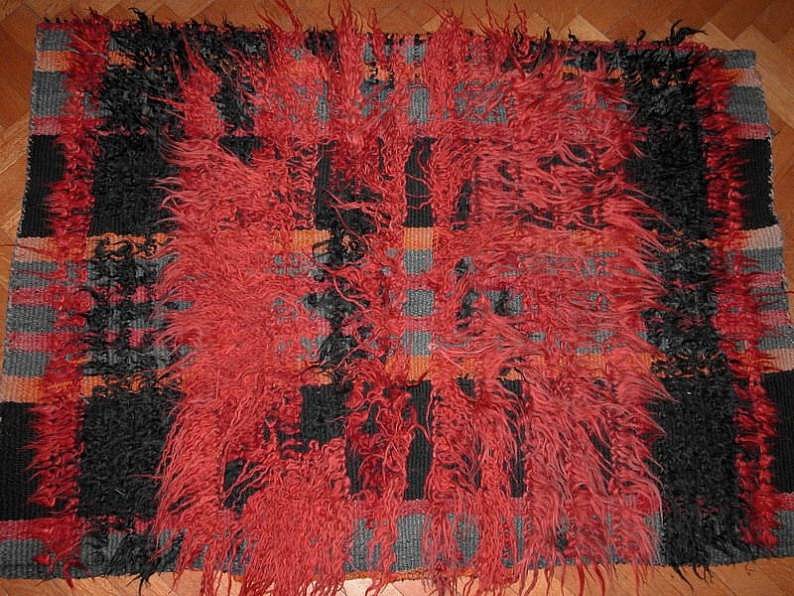



Chile, Mapuche Horse Blanket
The Mapuche Indians of southern Chile were famous for their horseback riding ability. They were the first Americans to learn how to ride horses in the New World. The slit in their tunics opened allowing them to spread their legs over the horse and these were the first true ponchos in the New World. A long pile colorful wool ceremonial horse blanket, which is very rare. A similar one is illustrated in "Colores de America" on the cover.
Period: Chile, Icalma Region, MAPUCHE, 19th Century, Villarcia
Media: Textile
Dimensions: Width 34" Height 48"
$6,500
97166
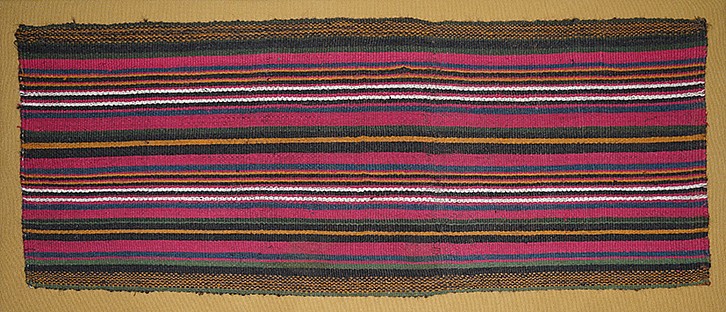



Chile, Pre-Inca Storage Bag from Arica, Chile
This large striped bag is decorated with a series of thin and broad vertical stripes in brilliant hues of red, green, tan, brown and white. The weaving was opened along the vertical sewn sides and is in excellent condition indicating that it was woven for ritual tribute rather than used in everyday life. These long, narrow bags are referred to as talegas. A group of talegas is catalogued in ARICA: 10,000 YEARS, ref # 195-199. Acquired in 1995 from Eduardo Aldunate, Santiago, Chile prior to the 1980s. Weaving Technique: plain weave. Professionally mounted on a stretcher.
Media: Textile
Dimensions: Length 29" x Width 13"
$5,800
95107
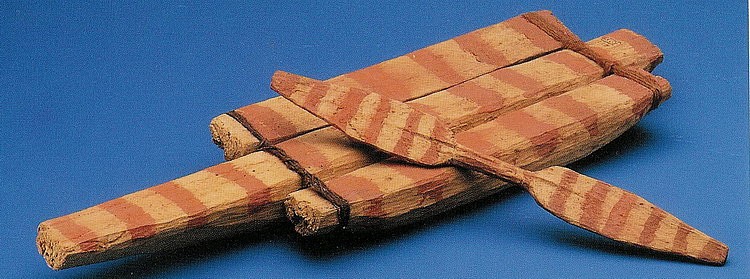
Chile, Small Chilean Arica Model Raft with Oar
This very rare model is intact with its original sea-lion leather lashing and double sided oar. These models are found in tombs and suggest that the deceased person was a sailor. This model is painted with red pigment. It is a small example but it is in excellent condition. The model is similar to one found in "THE INKA EMPIRE AND ITS ANDEAN ORIGINS" by Craig Morris.
Period: Chile, San Pedro de Atacama, circa AD300-900
Media: Wood
Dimensions: Length 10" x Width 3 1/4"
Price Upon Request
98095






